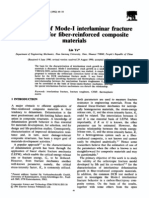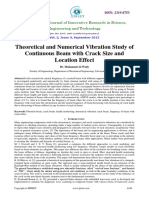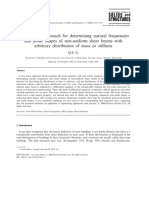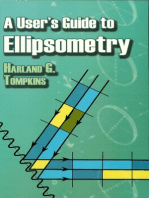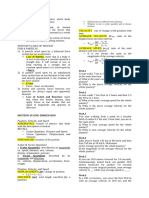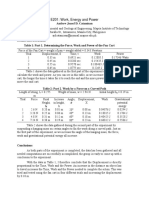Finite Element Analysis of A Cracked Cantilever Beam: Research Paper
Finite Element Analysis of A Cracked Cantilever Beam: Research Paper
Uploaded by
SanketCopyright:
Available Formats
Finite Element Analysis of A Cracked Cantilever Beam: Research Paper
Finite Element Analysis of A Cracked Cantilever Beam: Research Paper
Uploaded by
SanketOriginal Description:
Original Title
Copyright
Available Formats
Share this document
Did you find this document useful?
Is this content inappropriate?
Copyright:
Available Formats
Finite Element Analysis of A Cracked Cantilever Beam: Research Paper
Finite Element Analysis of A Cracked Cantilever Beam: Research Paper
Uploaded by
SanketCopyright:
Available Formats
International Journal of Advanced Engineering Research and Studies
E-ISSN22498974
Research Paper
FINITE ELEMENT ANALYSIS OF A CRACKED CANTILEVER
BEAM
Mihir Kumar Sutar
Address for Correspondence
Research Scholar, Department of Mechanical & Industrial Engineering
Indian Institute of Technology Roorkee, Roorkee, Uttrakhand, INDIA,
ABSTRACT
This paper describes the finite element analysis of a cracked cantilever and analyzes the relation between the modal natural
frequencies with crack depth, modal natural frequency with crack location. Also the relation among the crack depth, crack
location and natural frequency has been analyzed. Only single crack at different depth and at different location are evaluated.
And the analysis reveals a relationship between crack depth and modal natural frequency. As we know when a structure
suffers from damage its dynamic property can change and it was observed that crack caused a stiffness reduction with an
inherent reduction in modal natural frequencies. Consequently it leads to the change in the dynamic response of the beam.
The analysis was performed using ALGOR software. Modal natural frequency was found to be decreasing with increase in
crack depth. And the same was found to be increasing with increase in crack location from the fixed end.
KEYWORDS: Free Vibration; Crack; cantilever Beam; Modal Natural frequencies; ALGOR
1. INTRODUCTION
Being very commonly used in steel construction and
machinery industries, health monitoring and the
analysis of damage in the form of crack in Beam
structures poses a vital mean. Since long efforts are
on their way to find a feasible solution for crack
detection in beam structures in this regard many
approaches have so far being taken place. When a
structure suffers from damages, its dynamic
properties can change. Crack damage leads to
reduction in stiffness also with an inherent reduction
in natural frequency and increase in modal damping.
The paper gives a feasible relationship between the
modal natural frequency and the crack depth at
different location. Since free vibration analysis has
frequently become a topic of many studies therefore
attention is focused it only.
Crack localization and sizing in a beam from the free
and forced response measurements method is
indicated by Karthikeyan et al. [1]. In the beam
Timoshenko beam theory is used for modeling
transverse vibrations.FEM is used for the free and
forced vibration analysis of the cracked beam and
open transverse crack is selected for the crack model.
Being iterative in nature the iteration starts with a
guess for the crack depth ratio and iteratively
estimates the crack location and crack depth until the
desired convergence for both is reached.
The amount of literature related to damage detection
using shifts in resonant frequencies is quite large.
Salawu and Williams [2] presents an excellent review
on the use of modal frequency changes for damage
diagnostics. The observation that changes in
structural properties cause changes in vibration
frequencies was the impetus for using modal methods
for damage identification and health monitoring
Kim and Zhao [3] proposed a novel crack detection
method using harmonic response. It was concluded in
their paper that slope response has a sharp change
with the crack location and depth of the crack and
therefore it can used as a crack detection criterion. A
fault diagnosis method based on genetic algorithms
(GAs) and a model of damaged (cracked) structure is
proposed by Taghi et al. [4]. In their approach the
identification of the crack location and depth in the
cantilever beam is formulated as an optimization
problem, and binary and continuous genetic
IJAERS/Vol. I/ Issue II/January-March, 2012/285-289
algorithms (BGA, CGA) are used to find the optimal
location and depth by minimizing the cost function.
Ratcliffe [5] performed the frequency and curvaturebased experiments. Orhan [6] in his study analyzed
the free and forced vibration of a cantilever beam in
order to identify the crack of a cantilever beam.
Single and two edged crack were mainly evaluated in
his study. The investigation reveals that free vibration
analysis provides suitable information for the
detection of single and two cracks; whereas forced
vibration can detect only the single crack condition.
However, dynamic response of the forced vibration
better describes changes in crack depth and location
than the free vibration
Chang and Chen [7] presented technique for structure
damage detection based on spatial wavelet analysis
and the innovation of the proposed method is that
both the positions and depths of multi-cracks can be
estimated from spatial wavelet based method. First,
the mode shapes of free vibration and natural
frequencies of the multiple cracked beams are
obtained. It was observed from the analysis that the
positions and depths of the cracks can be predicted
with acceptable precision even though there are many
cracks in the beam.
2. FINITE ELEMENT FORMULATION
2.1 Governing Equation of Free Vibration
The free bending vibration of an Euler-Bernoulli
beam of a constant rectangular cross-section is given
by the following differential equation as given in:
EI
d4 y
dx
mw i2 y = 0
1
Where m is the mass of the beam per unit length
(kg/m), w i is the natural frequency of the ith mode
(rad/sec), E is the modulus of elasticity (N/m2) and I
is the moment of inertia (m4). By defining
4 = w i2 m / EI equation (1) is rearranged as a
fourth-order differential equation as follows:
d4 y
dx
4 y = 0
....2
The general solution to equation (2) is
International Journal of Advanced Engineering Research and Studies
E-ISSN22498974
y = Acos i x + Bsin i x + Ccosh i x + Dsinh i x
3
Where A, B, C, D are constants and i is a frequency
.13
parameter. Since the bending vibration is studied,
edge crack is modeled as a rotational spring with a
lumped stiffness. The crack is assumed open. Based
on this modeling, the beam is divided into two
segments: the first and second segments are left and
right-hand side of the crack, respectively. Adopting
Hermitian shape functions, the stiffness matrix of the
two-noded beam element without a crack is obtained
using the standard integration based on the variation
in flexural rigidity as
K e = [ B(x) ]T EI [ B(x)]dx
Where [ B(x)] =
And
.14
.15
.4
.16
H1" (x)H"2 (x)H"3 (x)H"4 (x) , 5
H1 (x) , H 2 (x) , H3 (x) , H 4 (x) are the
Hermitian shape functions defined as
.17
.6
.18
.7
lc = 1.5d, and is the distance between the left
.8
node and the crack. It is supposed that the crack does
not affect the mass distribution of the beam.
Therefore, the consistent mass matrix of the beam
element can be formulated directly as
l
.9
Assuming the beam rigidity EI is constant and is
given by EI0 within the element, and then the element
stiffness is
6l 12 6l
12
6l 4l2 6l 2l2
EI
e
0
K =
l3 12 6l 12 6l
6l 2l2 6l 4l2
K ec of the cracked element can be
written as
K ec = K e [ K c ]
Where
.11
[ K c ] is the reduction in the stiffness matrix
due to the crack. According to Peng et al. [8], the
matrix
[ K c ] is
k12
k11
k
k
[ K c ] = k12 k22
11
12
k 24
k14
k11
k12
k11
k14
.19
And we have
156 22l
Me = Al 22l 4l2
13l
420 54
13l 3l2
13l
13l 3l2
156 22l
22l 4l2
54
.20
.10
Assuming the stiffness reduction caused by as open
crack falls within a single element, and then the
stiffness matrix
Me = A [ H(x)]T [ H(x)]
k14
k 24
k14
k 44
Where
[ H(x)] = {H1 (x)H2 (x)H3 (x)H4 (x)}
In the dynamic analysis, the system matrix is usually
required to be inverted. From this aspect, a
diagonalized mass matrix has a computational
advantage. In this study, a diagonalized mass matrix
is adopted, which is developed from the consistent
mass matrix using the approach
39 0
Al
0 l
e
M =
78 0 0
0 0
0 0
39 0
0 l2
0
.21
The natural frequency then can be calculated from
the relation
w
.12
Where
IJAERS/Vol. I/ Issue II/January-March, 2012/285-289
[ M ] + [ K ]{q } =
.22
The natural frequency of the ith mode for uncracked
and cracked beams is finally obtained as follows
International Journal of Advanced Engineering Research and Studies
EI
w i0 = ci
w i = ri ci
E-ISSN22498974
assembled external force vector, and
ml
EI
.23
ml4
.24
w i0 is the ith mode frequency of the
uncracked beam and ci is a constant depending on
{q(t)}
is the
assembled vector of nodal degrees of freedom of the
system.
Let the force vector be defined as
{F(t)} = {F} e jwt
Where
Where
{}
.30
w is the forcing frequency, F is the force
the mode number and beam end conditions (for
clamped-free beam, ci is 3.516 and 22.034 for the
amplitude vector (elements of which are complex
w i is the i th
mode frequency of the cracked beam. r I is the ratio
{q(t)} = {q} e jwt
first and second mode, respectively),
between the natural frequencies of the cracked and
uncracked beam. l is the length of the beam.
2.2 Governing Equation of Forced Vibration
The Euler-Bernoulli beam is discretized into finite
beam element without crack and can be written as
..
[ M ](e) q(t)
(e)
+ [ K wc ]
(e)
Where [ M ]
(e)
{q(t)}(e) = {F(t)}(e)
.25
is the element mass matrix, [ K wc ](e)
is the element stiffness matrix,
{F(t)}(e)
is the
element external force vector, {q(t)}(e) is the element
vector of nodal degree of freedom and t is the time
instant. The subscript wc represents without crack.
And the subscript e represents element and the dot
represents the derivative with respect to the time. The
crack is assumed to affect only the stiffness. So the
equation of a cracked beam element can be expressed
as
(e)
[ M]
..
qc (t)
Where
{qc (t)}(e) is the nodal degree of freedom of
(e)
+ [Kc ]
(e)
{qc (t)}(e) = {F(t)}(e)
.26
the cracked element, the subscript c represent the
[ Kc ](e)
crack and
is the stiffness matrix of the
cracked element and is given as
1
[ K c ](e) = [T ][ C](e) [T ]T
.27
With
[C](e) = [C0 ](e) + [Cc ](e)
.28
[ C0 ](e) is the flexibility matrix of the
uncracked beam element, [Cc ](e) is the flexibility
Where
matrix of the crack, and [ C](e) is the total flexibility
matrix of the cracked beam element. Equations of
motion of the complete system can be obtained by
assembling the contribution of all equations of
motions motion for cracked and uncracked elements
in the system. Then the system equation of motion
becomes
..
[ M ] q(t) + [ K ]{q(t)} = {F(t)}
Where
[ M]
.29
is the assembled mass matrix,
the assembled stiffness matrix,
{F(t)}
[K]
is
is the
IJAERS/Vol. I/ Issue II/January-March, 2012/285-289
quantities) and j =
can be assumed as
Where
{q}
1 . Thus, the response vector
.31
is the response amplitude vector and
their elements are complex quantities. Substituting
the equations (30) and (31) into equation (29), the
system governing as follows:
( w
[ M ] + [ K ]) {q } = {F }
For a given system properties (i.e.
[ M]
.32
and
[K] )
the response can be simulated from equation (32)
corresponding to a given force {F } .
3. CONFIGURATIONS OF SIMULATED
CRACK
In this particular approach the free vibration of a
cantilever beam having V-shaped edge crack are
studied. The length of the beam is 800 mm and the
cross-section of the same is 50 x 6 mm2. As per the
material properties the modulus of elasticity (E) is 70
x 109 N/m2 and the mass density () is 2710 kg/m3.
Different crack configurations of same depth and at
different locations (from different distance from the
fixed end) are prepared to find out how the crack
affects the dynamic behavior of the beam. Crack
depth was kept constant at 0.202 mm and the crack
location from the fixed end was varied at instances of
50 mm, 100 mm, 200 mm, 300 mm, 400 mm, 500
mm, 600 mm and 700 mm. And the effect of crack
location on the natural frequencies was investigated.
Also the crack location from the fixed end was kept
constant and crack depth was varied from 0.05 to 4
mm at each step in order to investigate the effect of
crack depth on natural frequencies. Figure 1 shows
on of the total nineteen crack depths at a particular
crack locations where crack depth d varies from 0.05
to 4 mm.
Fig. 1 Single crack on the cantilever beam at
300 mm length from the fixed end
4. THE FINITE ELEMENT MODELING
ALGOR software was used for the free vibration
analysis of the uncracked and cracked beams. For this
purpose a model of the uncracked and cracked beams
was prepared in the CATIAV5R15 and the same
were brought into the ALGOR environment and the
mesh was generated. The beam was discretized into
International Journal of Advanced Engineering Research and Studies
E-ISSN22498974
8250 elements with 11746 nodes. The cantilever
boundary conditions were modeled by constraining
all degrees of freedom of the nodes located at the left
hand side of the beam. Figure 2 shows the finite
element mesh model of the beam element. Three
modes were selected to extract and first 3 modes of
natural frequencies were calculated for uncracked and
cracked beam. This procedure was thereafter repeated
for different crack scenarios. The crack zone portion
with arrow mark is being highlighted in figure 3.
Fig. 6 Third mode Natural Frequency versus
crack depth
Fig. 2 Finite Element Model of cantilever Beam in
ALGOR environment
Fig. 3 Details of crack zone
6. RESULTS
The change in natural frequencies with crack depth
for three different modes is plotted in figure 4, 5 and
6. And it was observed that in all the cases the modal
natural frequencies decrease with increase in crack
depth.
Fig. 4 First Mode Natural Frequency versus crack
depth
Fig. 7 Comparison of First Mode Natural
Frequency at 50 mm and 500 mm
As shown in Figure 7 as the crack location from the
fixed end increases the modal natural frequencies
also increases. A comparison has been made between
the First Mode of natural frequencies at crack lengths
of 50 and 500 mm from the fixed end respectively at
subsequent crack depths.
Fig. 8 Three dimensional cum contour plot for
relative First Mode Natural Frequency
The relation among the crack depth, crack location
and natural frequency has also being analyzed and is
plotted as shown in the figure 8 .Only First mode of
vibration of vibration is considered for this
comparison. And it was observed that as the crack
location from the fixed end increases the modal
natural frequency also increases. And when the crack
depth at a particular crack location increases the
modal natural frequency decreases.
REFERENCES
1.
2.
Fig. 5 Second Mode Natural frequency versus
crack depth
IJAERS/Vol. I/ Issue II/January-March, 2012/285-289
M. Karthikeyan, R. Tiwari, S. Talukdar (2006). Crack
localization and sizing in a beam based on the free and
forced response measurements. Mechanical Systems
and Signal Processing 21 (2007). pp. 13621385
Salawu, O. S. and Williams, C., 1993, Structural
Damage Detection Using Experimental Modal Analysis
International Journal of Advanced Engineering Research and Studies
3.
4.
5.
6.
7.
8.
A Comparison Of Some Methods, in Proc. of 11th
International Modal Analysis Conference, pp. 254260
Kim M-B, Zhao M. Study on crack detection of beam
using harmonic responses. Proceedings of the 2004
international conference on intelligent mechatronics and
automation, August 2004, Chengdu, China, p.726.
Mohammad-Taghi
Vakil-Baghmisheh,
Mansour
Peimani, Morteza Homayoun Sadeghi, Mir Mohammad
Ettefagh (2007). Crack detection in beam-like structures
using genetic algorithms. Applied Soft Computing 8
(2008). pp. 11501160.
C.P. Ratcliffe, Frequency and curvature based
experimental method for locating damage in structures,
J. Vibration Acoustic. 122 (2000) 324329.
Sadettin Orhan (2007). Analysis of free and forced
vibration of a cracked cantilever beam. NDT&E
International 40 (2007). pp. 443450.
Chih-Chieh Chang, Lien-Wen Chen(2005). Detection
of the location and size of cracks in the multiple cracked
beam by spatial wavelet based approach. Mechanical
Systems and Signal Processing. Vol.19. pp.139155
Peng, Z. K., Lang, Z. Q., Billings, S.A.(2007), Crack
Detection using nonlinear output frequency response
functions. Journal of Sound and Vibration, 301, pp.
777-788.
IJAERS/Vol. I/ Issue II/January-March, 2012/285-289
E-ISSN22498974
You might also like
- Ipc 2152Document5 pagesIpc 2152Abner Franco0% (2)
- Rotating UnbalanceDocument4 pagesRotating UnbalanceAngelNo ratings yet
- Vibration Analysis of A Cracked Beam Using Various Techniques - A ReviewDocument4 pagesVibration Analysis of A Cracked Beam Using Various Techniques - A ReviewAsif ChaudryNo ratings yet
- Identification of Multiple Cracks in A Beam Using Natural Frequencies, Lee, 2009Document9 pagesIdentification of Multiple Cracks in A Beam Using Natural Frequencies, Lee, 2009masi1975No ratings yet
- Vibration Analysis of Multiple Cracked ShaftDocument6 pagesVibration Analysis of Multiple Cracked ShaftIJMERNo ratings yet
- Vibration AnalysisDocument8 pagesVibration AnalysisKajal KhanNo ratings yet
- Application of Differential Transform Method in Free Vibration Analysis of Rotating Non-Prismatic BeamsDocument8 pagesApplication of Differential Transform Method in Free Vibration Analysis of Rotating Non-Prismatic BeamsKhairul Anuar RahmanNo ratings yet
- Studies On Effect of Change in Dynamic Behavior of Crack Using FemDocument7 pagesStudies On Effect of Change in Dynamic Behavior of Crack Using FemMatthew SmithNo ratings yet
- Natural Characteristics Research of MW Wind Turbine TowerDocument5 pagesNatural Characteristics Research of MW Wind Turbine TowerSEP-PublisherNo ratings yet
- Study On Improvement of Damping in Jointed Cantilever Beams Using FEMDocument8 pagesStudy On Improvement of Damping in Jointed Cantilever Beams Using FEMHamed MasterNo ratings yet
- Influence of Crack On Modal Parameters of Cantilever Beam Using Experimental Modal AnalysisDocument8 pagesInfluence of Crack On Modal Parameters of Cantilever Beam Using Experimental Modal Analysisdadi amirNo ratings yet
- Ijmet: ©iaemeDocument8 pagesIjmet: ©iaemeIAEME PublicationNo ratings yet
- Analysis of Free and Forced Vibration of A CrackedDocument9 pagesAnalysis of Free and Forced Vibration of A CrackedTwinNo ratings yet
- Theoretical and Software Analysis of Crack Detection in StructureDocument4 pagesTheoretical and Software Analysis of Crack Detection in StructureerpublicationNo ratings yet
- Sensing Delaminations With Particulate Mag-Netostrictive SensorsDocument10 pagesSensing Delaminations With Particulate Mag-Netostrictive SensorsOliver J. MyersNo ratings yet
- Crack Detection of Structure For Plane Problem With Spatial WaveletsDocument13 pagesCrack Detection of Structure For Plane Problem With Spatial WaveletsMichael FibreNo ratings yet
- 1 s2.0 0013794494001758 Main PDFDocument27 pages1 s2.0 0013794494001758 Main PDFshashank soniNo ratings yet
- Investigation of Bending Loss in A Single-Mode Optical FibreDocument13 pagesInvestigation of Bending Loss in A Single-Mode Optical FibreMuhammad OmerNo ratings yet
- Evaluation of Mode-I Inter Laminar Fracture Toughness For Fiber Reinforced Composite MaterialsDocument6 pagesEvaluation of Mode-I Inter Laminar Fracture Toughness For Fiber Reinforced Composite Materialsn_kosmasNo ratings yet
- Beam TheoryDocument35 pagesBeam TheoryEnriqueGD100% (1)
- International Journal of Mechanical Sciences: Mostafa AttarDocument15 pagesInternational Journal of Mechanical Sciences: Mostafa AttarDamarla KiranNo ratings yet
- 3D Analysis of Failure Modes in The Charpy Impact TestDocument21 pages3D Analysis of Failure Modes in The Charpy Impact TestEdna Odette Melo UscangaNo ratings yet
- Ansys ThesisDocument55 pagesAnsys ThesismallidataworksNo ratings yet
- Theoretical and Numerical Vibration Study of Continuous Beam With Crack Size and Location EffectDocument12 pagesTheoretical and Numerical Vibration Study of Continuous Beam With Crack Size and Location EffectMurali MohanNo ratings yet
- Modelling and Eigen Frequency Analysis of Piezoelectric Cantilever BeamDocument8 pagesModelling and Eigen Frequency Analysis of Piezoelectric Cantilever BeamTI Journals PublishingNo ratings yet
- Ultrasound Material Backscattered Noise Analysis by A Duo Wavelet-Regression AnalysisDocument5 pagesUltrasound Material Backscattered Noise Analysis by A Duo Wavelet-Regression Analysisnishant361No ratings yet
- Shear Band Formation in Granular Materials: A Micromechanical ApproachDocument7 pagesShear Band Formation in Granular Materials: A Micromechanical ApproachgeoanagoNo ratings yet
- Journal of Mechanical Engineering Science 1978 Rao 271 82Document13 pagesJournal of Mechanical Engineering Science 1978 Rao 271 82mehtabpathanNo ratings yet
- A Timoshenko Beam ElementDocument13 pagesA Timoshenko Beam ElementPavan KishoreNo ratings yet
- Analysis of Nonlinear Vibro-Acoustic Wave Modulations Used For Impact Damage Detection in Composite StructuresDocument7 pagesAnalysis of Nonlinear Vibro-Acoustic Wave Modulations Used For Impact Damage Detection in Composite StructuresferdincaninNo ratings yet
- Ebenezer 2002 Curr Science OctDocument8 pagesEbenezer 2002 Curr Science OctDuraisingh Diamond EbenezerNo ratings yet
- Vibration Analysis of Beam With Varying Crack Location: AbstractDocument10 pagesVibration Analysis of Beam With Varying Crack Location: AbstractShkelzen ShabaniNo ratings yet
- Free Vibration of Cracked BeamDocument12 pagesFree Vibration of Cracked BeamMaheswaran MuthaiyanNo ratings yet
- Damage Detection FRM Mode Shape 1Document12 pagesDamage Detection FRM Mode Shape 1Abdul Khader ShahadafNo ratings yet
- SPE 168606 A New Method For Fracture Diagnostics Using Low Frequency Electromagnetic InductionDocument11 pagesSPE 168606 A New Method For Fracture Diagnostics Using Low Frequency Electromagnetic Inductionamramazon88No ratings yet
- Gawande 2016Document16 pagesGawande 2016ahmad.m.mosa99No ratings yet
- Crack Detection in Beam Type Structure Using FrequDocument37 pagesCrack Detection in Beam Type Structure Using FrequjayaNo ratings yet
- Beams Free Transverse Vibrations of Nano-To-Micron Scale:, 2977-2995 2006 Mingtian XuDocument20 pagesBeams Free Transverse Vibrations of Nano-To-Micron Scale:, 2977-2995 2006 Mingtian XuEric AmbroziniNo ratings yet
- Determination of Natural Frequency of Euler's Beams Using Analytical and Finite Element MethodDocument75 pagesDetermination of Natural Frequency of Euler's Beams Using Analytical and Finite Element MethodAnonymous oYSrguZNo ratings yet
- 1 s2.0 S0022460X97909925 MainDocument14 pages1 s2.0 S0022460X97909925 MainItalo RodriguesNo ratings yet
- Fem Analysis On Mixed-Mode Fracture of CSM-GRP: - FF y 0, A - T O, P (P, S)Document13 pagesFem Analysis On Mixed-Mode Fracture of CSM-GRP: - FF y 0, A - T O, P (P, S)Ramesh SantanaNo ratings yet
- Strain 95 j2Document37 pagesStrain 95 j2Ramprasad SrinivasanNo ratings yet
- Advanced Mechanics of Solids by Arthur P Boresi & Schmidth 6 EdDocument8 pagesAdvanced Mechanics of Solids by Arthur P Boresi & Schmidth 6 EdChaitanya RamNo ratings yet
- Hutchinson Fracture Delamination of Beams Under Transverse Shear and BendingDocument10 pagesHutchinson Fracture Delamination of Beams Under Transverse Shear and BendingTashi MalhotraNo ratings yet
- Effect of Crack Location and Crack Depth On Natural Frequencies of Fixed Beam Using Experimental Modal AnalysisDocument12 pagesEffect of Crack Location and Crack Depth On Natural Frequencies of Fixed Beam Using Experimental Modal Analysisdadi amirNo ratings yet
- Electric Field and Potential Distributions Along Surface of Silicone Rubber Polymer Insulators Using Finite Element MethodDocument6 pagesElectric Field and Potential Distributions Along Surface of Silicone Rubber Polymer Insulators Using Finite Element Methodostojic007No ratings yet
- Ijet 25318 PDFDocument3 pagesIjet 25318 PDFNirmal KushwahaNo ratings yet
- 5 Ijmperddec20175Document10 pages5 Ijmperddec20175TJPRC PublicationsNo ratings yet
- SURVISHNO Anu Revised 05 1Document7 pagesSURVISHNO Anu Revised 05 1douharbidi12No ratings yet
- Vibration-Based Methods For Detecting A Crack in A Simply Supported BeamDocument14 pagesVibration-Based Methods For Detecting A Crack in A Simply Supported BeamDhananjay BaviskarNo ratings yet
- The Application of Spectral Kurtosis-2010Document26 pagesThe Application of Spectral Kurtosis-2010Alessandro CastagnaNo ratings yet
- MAC13Document16 pagesMAC13rompnadegasNo ratings yet
- Computational Mechanics: M. Iura and S. N. AtluriDocument12 pagesComputational Mechanics: M. Iura and S. N. AtluriShivan DoskyNo ratings yet
- JETIRE006088Document8 pagesJETIRE006088Ritu MaityNo ratings yet
- Mechanical Systems and Signal Processing: Maosen Cao, Lin Ye, Limin Zhou, Zhongqing Su, Runbo BaiDocument14 pagesMechanical Systems and Signal Processing: Maosen Cao, Lin Ye, Limin Zhou, Zhongqing Su, Runbo BaidzenekNo ratings yet
- CIVN4002 FREE VIBRATION LAB ReportDocument9 pagesCIVN4002 FREE VIBRATION LAB ReportprincethapelokomeNo ratings yet
- Li 2000Document19 pagesLi 2000emad samirNo ratings yet
- Damage Detection With Coin-TapDocument5 pagesDamage Detection With Coin-TapGabriel N GonzalezNo ratings yet
- Vibration Analysis ofDocument12 pagesVibration Analysis ofMonikashish JaiswalNo ratings yet
- Aerospace MechanicsDocument66 pagesAerospace MechanicsKenneth John Ibarra100% (1)
- Steam TablesDocument12 pagesSteam Tablesgrumpyfecker1988No ratings yet
- Bombeo MecanicoDocument14 pagesBombeo MecanicoMind´s EyesNo ratings yet
- All ComDocument47 pagesAll Comkushagrajoshi69No ratings yet
- Class-9th Motion Force and Laws of Motion TestDocument1 pageClass-9th Motion Force and Laws of Motion Testtarun aroraNo ratings yet
- Quantum Mechanics - Historical BackgroundDocument2 pagesQuantum Mechanics - Historical BackgroundN4draNo ratings yet
- DYNAMICSDocument7 pagesDYNAMICSSting Spectre GoNo ratings yet
- Q. 1 - Q. 5 Carry One Mark EachDocument14 pagesQ. 1 - Q. 5 Carry One Mark EachPavan KumarNo ratings yet
- Altair HyperWorks BrochureDocument80 pagesAltair HyperWorks BrochureakashthilakNo ratings yet
- Solutions To Irodov's Problems - Volume IDocument522 pagesSolutions To Irodov's Problems - Volume IZequinha de Abreu83% (6)
- Wet Comminution in Stirred Media Mills: ReviewDocument12 pagesWet Comminution in Stirred Media Mills: ReviewVictor Manuel Morales de la FuenteNo ratings yet
- Fluid Mechanics & Fluid Machines (Book)Document271 pagesFluid Mechanics & Fluid Machines (Book)Shivam Agrahari0% (1)
- Digital Control Tutorial No 2Document10 pagesDigital Control Tutorial No 2Mary DunhamNo ratings yet
- Ansys Shell 63 Elementansys Shell 63 Elementansys Shell 63 ElementDocument10 pagesAnsys Shell 63 Elementansys Shell 63 Elementansys Shell 63 ElementvilukNo ratings yet
- Hook Load - FULLTEXT01 PDFDocument84 pagesHook Load - FULLTEXT01 PDFMarcoNo ratings yet
- Physics Quiz Branches, Physicists, SF & Sci NotationDocument3 pagesPhysics Quiz Branches, Physicists, SF & Sci NotationJulz SanchezNo ratings yet
- Gravity and Motion WorksheetDocument2 pagesGravity and Motion WorksheetAlyaa EldafrawyNo ratings yet
- Heliocentric Model Empirical Model.: AssumedDocument3 pagesHeliocentric Model Empirical Model.: AssumedM.K. TongNo ratings yet
- Ship's Hull Theory II, Stability (Module 1)Document17 pagesShip's Hull Theory II, Stability (Module 1)ScarletRahadyanNo ratings yet
- Dr. Tauseef Ahmad Ansari: Fluid DynamicsDocument37 pagesDr. Tauseef Ahmad Ansari: Fluid DynamicsTauseefNo ratings yet
- Live Class Notes Avnish Sir 26-11-2020Document44 pagesLive Class Notes Avnish Sir 26-11-2020Rakesh KumarNo ratings yet
- Catamisan, Andrew Jozsef D. Phy11l A4 E201 3q1617Document2 pagesCatamisan, Andrew Jozsef D. Phy11l A4 E201 3q1617Avaricious AndrewNo ratings yet
- MatlabDocument39 pagesMatlabDrSanjeev K Chaudhary100% (1)
- 2 Marks Dynamics of MachineryDocument36 pages2 Marks Dynamics of MachineryMartin De Boras PragashNo ratings yet
- Physics Model Paper XI (Paper II)Document8 pagesPhysics Model Paper XI (Paper II)Taqi Abbas6713No ratings yet
- Ook Eview: Lattice Boltzmann Method: Fundamentals and Engineering Applications With Computer CodesDocument2 pagesOok Eview: Lattice Boltzmann Method: Fundamentals and Engineering Applications With Computer CodesjoshuaNo ratings yet
- Revision Test 1 Physics Xii U-IDocument4 pagesRevision Test 1 Physics Xii U-Ivictoria schoolNo ratings yet


















